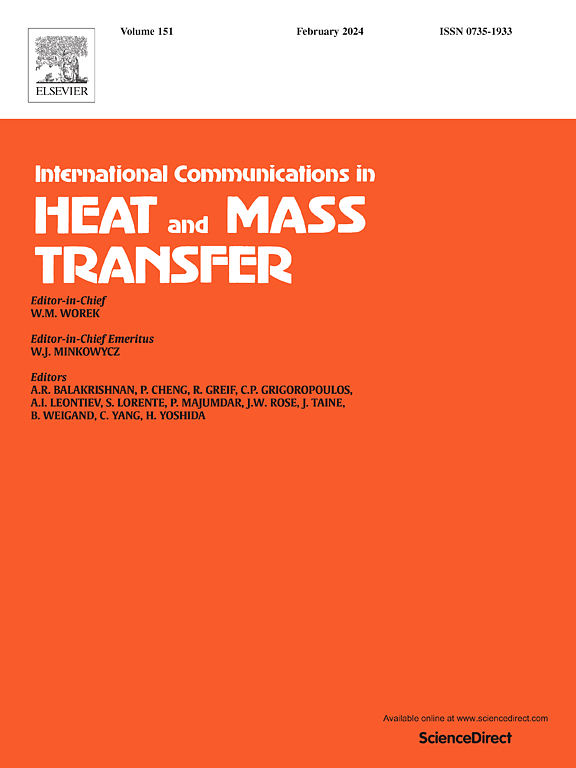Dynamic heat transfer characteristics of R-410A refrigerant in saturated flow boiling under oscillating mass flux conditions
IF 6.4
2区 工程技术
Q1 MECHANICS
International Communications in Heat and Mass Transfer
Pub Date : 2025-02-05
DOI:10.1016/j.icheatmasstransfer.2025.108681
引用次数: 0
Abstract
The study investigates the unsteady saturated flow boiling heat transfer of R-410A in a horizontal annular channel, focusing on the effects of oscillating mass flux. Key parameters, including mean mass flux, amplitude and period of oscillation, input thermal flux, and saturation temperature, are examined to determine their influence on boiling curves and heat transfer coefficients (HTC). Baseline steady-state experiments show that mass flux oscillation has minimal effect on boiling curves beyond nucleate boiling, where fully developed nucleate boiling governs heat transfer. Under oscillatory flow conditions, three distinct flow regimes are identified: single-phase flow, sporadic boiling flow, and persistent boiling flow. Periodic variations in mass flux induce corresponding oscillations in both wall temperature (Tw) and boiling HTC, with larger amplitude and frequency of oscillation enhancing thermal response. At higher thermal flux, wall temperature decreases with reduced mass flux, opposite to the trend observed in single-phase flow. For moderate heat flux levels, oscillations in Tw and HTC are minimal, while larger oscillation periods result in more pronounced fluctuations in temperature and HTC. These findings offer valuable insights into the dynamic heat transfer behavior of R-410A, contributing to the optimization of thermal management systems for industrial applications operating under unsteady flow conditions.
求助全文
约1分钟内获得全文
求助全文
来源期刊
CiteScore
11.00
自引率
10.00%
发文量
648
审稿时长
32 days
期刊介绍:
International Communications in Heat and Mass Transfer serves as a world forum for the rapid dissemination of new ideas, new measurement techniques, preliminary findings of ongoing investigations, discussions, and criticisms in the field of heat and mass transfer. Two types of manuscript will be considered for publication: communications (short reports of new work or discussions of work which has already been published) and summaries (abstracts of reports, theses or manuscripts which are too long for publication in full). Together with its companion publication, International Journal of Heat and Mass Transfer, with which it shares the same Board of Editors, this journal is read by research workers and engineers throughout the world.

 求助内容:
求助内容: 应助结果提醒方式:
应助结果提醒方式:


